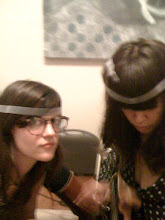The avant-garde icon will present a live work at the Film Studies Center.
LIGHT MOTIF Jacobs, inset, performs at the Paris Cinematheque. “The Green Wave,” background, is a DV experiment in stereoscopic imagery “without spectacles.”
For more than 50 years, Ken Jacobs has been a key figure in American experimental cinema, creating a steady stream of acclaimed and influential films, live moving-image works and, more recently, digital videos. He is best known for his seminal Tom, Tom, the Piper’s Son (1969), which expands a 1905 film into a feature-length exploration of its form and images, and the decades-in-the-making, seven-hour epic Star Spangled to Death (2003). But even those familiar with Jacobs’s filmmaking might be astonished at the sheer number of live works he’s done over the years, including shadow plays, his amazing Nervous System setup (in which two projectors and a rotating shutter allow for near-forensic investigations of film material) and the Nervous Magic Lantern, a simpler but no less amazing device that hearkens back to 19th-century technology. The NYC-based filmmaker, 77, will perform a work with the latter on Thursday 5. We e-mailed him about
his first appearance in Chicago in three decades.
You’ve been doing live-projection works almost as long as you’ve been making films. What first interested you in these more ephemeral kinds of “cinema”? How and why did you start?
With my first money for a film projector, in 1954, I bought a Kodak Film Analyst for examining 16mm film at various speeds—going backwards and forwards. Occasionally, friends would sit in on these studies, which I never thought about as performance.… In 1975, teaching in Binghamton [New York], I mentioned an idea to a fellow artist-teacher, Dan Barnett: using both of the department’s stop-motion projectors to hold sequential frames on screen from two prints of a film, polarized, and viewing them with polaroid spectacles.… Dan was enthusiastic and we tried it. And it was a dream come true. The scene suddenly appeared in deep space. Space was a turn-on for me. This led to my first public film performance, The Impossible: Chapter One, South’wark Fair.
The Nervous Magic Lantern and Nervous System performances seem to come from the same interests that led to Tom, Tom, the Piper’s Son: a fascination with early cinema, exploring the material of film and transforming and abstracting reality, but heightened by the possibility of creating 3-D. Do you see them as related?
My interest in [the 1905] “Tom, Tom” came about because it seemed such a disaster; the primitive film-making was showing all over it. It showed its age. Now and again I saw a character look into the camera, looking at me 60 years later. The role fell away and here was a human. I was touched by this and that got me into chasing down the reality of what is this strange ribbon of images called film. Four of the five chapters of The Impossible utilized and further investigated scenes from “Tom, Tom.” I would be coming up with different techniques but the impulse to create crazy 3-D events was consistent.
Can you describe a bit what the Nervous Magic Lantern is and what audiences can expect?
The Nervous Magic Lantern has got to be the strangest thing I ever attempted. It came to me in a dream, and made no sense. No projector has ever been more basic: a light, a lens, a shutter and some space between light and lens for me to fool around. Images are vastly 3-D and going through impossible changes. I’m enjoying it with audiences as long as I can before it’s declared illegal.
Jacobs and his wife, Flo, will present one of his Nervous Magic Lantern works, Time Squared, along with two digital videos, at the Film Studies Center at the University of Chicago Thursday 5 at 7pm.

No comments:
Post a Comment